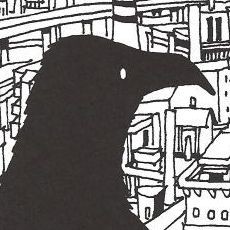
I’ve seen Ghost in the Shell many times; the most recent happened to be Friday night. It is a beautiful film, both beautifully animated and beautifully directed, only 80 minutes long too, and just as importantly, every time I watch it, I feel like I’m interpreting it in a slightly different way.
I first stumbled across Ghost in the Shell as a young teenager and was almost exclusively interested in the film’s iconic visuals. You know, like Batou pulling his gun in the crowded market-place and the abrasive sound of the gun fire, the Major’s brief yet brutal kung-fu fight in the midst of that shallow river; only her shadow visible against the calm water. The list goes on, yet with each new viewing, it is the film’s more introspective moments that continue to haunt me.
This all began with the Anime World Order’s recent review of Angel’s Egg, probably the most infamous film of (director) Mamoru Oshii‘s career. In the film (which I haven’t seen, incidentally), a lonely girl aimlessly wanders about a desolate landscape, carrying with her a precious egg that she believes incubates her dying world’s last saviour. All her hopes and dreams are pinned on this (Angel’s) egg, but in the end, it breaks. The egg is empty.
Notably, the AWO review discusses how Oshii was an extremely religious person in his youth and had even intended to become a Christian priest, until something happened in his life, some pivotal moment that obviously pushed him towards his career in anime. Quite what that something was remains unknown, but it is suggested that Angel’s Egg is Oshii‘s criticism of religion, or rather, the blind faith that it encourages. Such was my mindset as I approached this latest viewing of Ghost in the Shell, the film’s very title an allusion to the human soul.

If one can presume that Oshii had lost his faith, then Ghost in the Shell could be seen as a film about Major Kusanagi’s struggle to find some meaning in, or proof to, her existence, in a world where everything is manufactured; where even her body is artificial.
In her free time, Kusanagi dives into the depths of the sea, but since her cyborg body is too heavy to swim, she relies completely on her equipment to carry her back to the surface. She knows that any tiny malfunction could be fatal, but she does it anyway, precisely because it is frightening and dangerous, because to fear death is to value life, and in that brief moment, she feels alive.
One can imagine Oshii‘s struggle. If someone grows up believing in a god, believing there is an underlying purpose to everything that happens; only to suddenly lose faith, that person would feel lost and alone. That feeling mirrors Kusanagi’s own melancholy and search for what it means to be alive. People often think of their souls, that essence of their individuality, as invisibly residing within their own flesh and blood, but without even her own body to fall back on, what else is left for Kusanagi to call her own? Likewise, if such a deeply religious person suddenly loses faith in the existence of his soul, what is it that defines his reality? What proves that he is alive?
The straightest answer is death. Life has no meaning without it, hence, at the end of Ghost in the Shell, the Puppet Master (Project 2501) has realised that the only way he/she can genuinely evolve into something that is alive is by acquiring the power to die. He chooses to ‘merge’ with Kusanagi because she shares similar doubts; her life may be artificial, but at least by agreeing to the Puppet Master’s plans, she has taken control of her own fate, and even if that path leads to her demise, it was through her own choice; if just for a few minutes, it proves that she was alive.
My own interpretation is that Ghost in the Shell is a film about the importance of free will, that the ability to act to one’s own accord, even if it means self destruction, is always preferable to a life with no purpose other than to blindly serve. I don’t know if that sounds depressing or not, really, I just know that I still love this film after all these years.

Leave a Reply